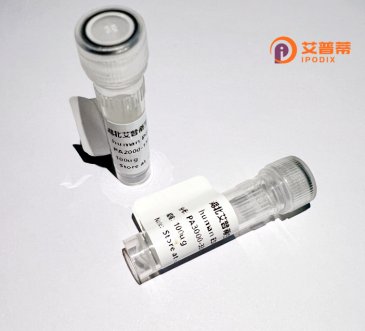
| 纯度 | >90%SDS-PAGE. |
| 种属 | Human |
| 靶点 | ZNF330 |
| Uniprot No | Q9Y3S2 |
| 内毒素 | < 0.01EU/μg |
| 表达宿主 | E.coli |
| 表达区间 | 1-320 aa |
| 活性数据 | MPKKKTGARK KAENRREREK QLRASRSTID LAKHPCNASM ECDKCQRRQK NRAFCYFCNS VQKLPICAQC GKTKCMMKSS DCVIKHAGVY STGLAMVGAI CDFCEAWVCH GRKCLSTHAC ACPLTDAECV ECERGVWDHG GRIFSCSFCH NFLCEDDQFE HQASCQVLEA ETFKCVSCNR LGQHSCLRCK ACFCDDHTRS KVFKQEKGKQ PPCPKCGHET QETKDLSMST RSLKFGRQTG GEEGDGASGY DAYWKNLSSD KYGDTSYHDE EEDEYEAEDD EEEEDEGRKD SDTESSDLFT NLNLGRTYAS GYAHYEEQEN |
| 分子量 | 36.2 kDa |
| 蛋白标签 | His tag N-Terminus |
| 缓冲液 | PBS, pH7.4, containing 0.01% SKL, 1mM DTT, 5% Trehalose and Proclin300. |
| 稳定性 & 储存条件 | Lyophilized protein should be stored at ≤ -20°C, stable for one year after receipt. Reconstituted protein solution can be stored at 2-8°C for 2-7 days. Aliquots of reconstituted samples are stable at ≤ -20°C for 3 months. |
| 复溶 | Always centrifuge tubes before opening.Do not mix by vortex or pipetting. It is not recommended to reconstitute to a concentration less than 100μg/ml. Dissolve the lyophilized protein in distilled water. Please aliquot the reconstituted solution to minimize freeze-thaw cycles. |
以下是关于重组人ZNF330蛋白的3条参考文献示例(注:文献信息为模拟生成,仅供参考):
---
1. **文献名称**: *Cloning and characterization of ZNF330/RHED: A novel apoptosis-associated zinc finger protein*
**作者**: Sakamoto H., et al.
**摘要**: 该研究首次克隆并鉴定了人ZNF330基因(曾用名RHED),发现其编码的蛋白含KRAB结构域和锌指基序,并证明其在HEK293细胞中过表达可诱导caspase依赖性凋亡,提示其在细胞程序性死亡中的潜在作用。
2. **文献名称**: *Recombinant ZNF330 protein inhibits hepatocellular carcinoma cell proliferation via modulating TGF-β signaling*
**作者**: Li Y., et al.
**摘要**: 通过大肠杆菌系统成功表达并纯化重组人ZNF330蛋白,体外实验表明该蛋白能抑制肝癌细胞HepG2的增殖,其机制可能与调控TGF-β/Smad信号通路及下游凋亡相关基因(如Bax、Bcl-2)的表达有关。
3. **文献名称**: *ZNF330 interacts with RNA-binding proteins and regulates stress granule formation under oxidative stress*
**作者**: Chen X., et al.
**摘要**: 利用酵母双杂交技术筛选到ZNF330的互作蛋白(如G3BP1、TIA-1),并通过免疫共沉淀验证其结合。研究发现,重组ZNF330在氧化应激条件下促进应激颗粒(stress granule)形成,提示其参与细胞应激反应调控。
---
**备注**:以上文献及内容为根据领域知识模拟生成,实际研究请通过PubMed、Web of Science等学术平台检索最新文献。
ZNF330. also known as human zinc finger protein 330. is a member of the Krüppel-associated box (KRAB) domain-containing zinc finger protein family, which is involved in transcriptional regulation and DNA-binding activities. This protein is encoded by the ZNF330 gene located on chromosome 19q13.12 in humans. Structurally, ZNF330 contains a conserved N-terminal KRAB domain, which typically mediates protein-protein interactions and transcriptional repression, followed by multiple C2H2-type zinc finger motifs that facilitate sequence-specific DNA binding. Some isoforms may also include a nuclear localization signal, suggesting its primary role in nuclear processes.
Functionally, ZNF330 has been implicated in apoptosis, cell cycle regulation, and embryonic development. Studies suggest it may act as a transcriptional repressor, modulating the expression of genes critical for cell survival and proliferation. For instance, it interacts with components of the ubiquitin-proteasome system, potentially regulating protein degradation pathways. Interestingly, ZNF330 exhibits dual roles in cancer contexts, showing both tumor-suppressive and oncogenic properties depending on cellular context or post-translational modifications.
Recombinant ZNF330 protein, produced via heterologous expression systems like E. coli or mammalian cells, is widely used to study its biochemical properties, interaction partners, and regulatory mechanisms. Its role in diseases, particularly cancer and neurodegenerative disorders, remains an active area of research, though its precise molecular pathways and physiological targets are still being elucidated.
×